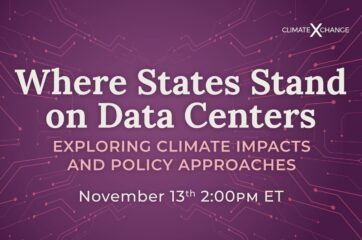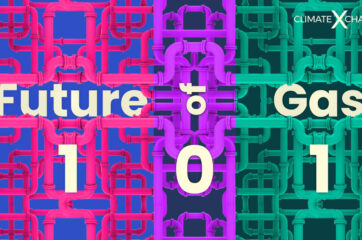As the federal government threatens states’ authority to regulate climate policy, environmental rights amendments (ERAs) present a key opportunity for states to guarantee the right to a clean and healthy environment through a constitutional mandate. These amendments can be used to advance critical efforts in the states where they exist, protecting residents against groundwater contamination, hazardous air pollution, natural resource extraction, and other climate and environmental impacts. They also can be a key tool in regulating greenhouse gas emissions.
We invited a panel of experts to dive into the basics of ERAs, including key policy design considerations and how they’ve been used to secure legal victories. Our expert panel included Sara Zimmerman, Founder and Executive Director of the Climate Equity Policy Center; Maya K. van Rossum, Founder and Leader of Green Amendments for the Generations; and Mat dos Santos, Co-Executive Director and General Counsel at Our Children’s Trust
Environmental Rights Amendments: Overview and Opportunities
Sara Zimmerman, Climate Equity Policy Center
Learn more by watching the webinar at 04:49
Sara provided an introduction to environmental rights amendments (ERAs) and their importance. Her presentation covered the following topics:
- ERAs are a simple, powerful tool for giving legal weight to the right to a healthy environment and directing local and state governments to protect this right.
- ERAs, enacted at the state level since the 1970s, are present in seven states: Illinois, Pennsylvania, Massachusetts, Montana, Hawaiʻi, Rhode Island, and New York.
- ERA design should consider which core rights are necessary to protect, how to incorporate public trust and private lawsuit language, and what details are required to ensure they’re interpreted properly in courts.
- There are two main methods of ERA enactment:
- Citizen-proposed amendments, placed on the ballot after a certain number of signatures are collected — only some states allow this
- State legislature-proposed amendments, typically submitted to voters after passing the legislature — all states allow this, and all existing ERAs utilized this method
- To pass an ERA, advocates should explore state-specific considerations like political climate, voter interest, allies and partners, etc. Logistically, you must understand the legislative rules and signature requirements around ballot initiatives, and which path to enactment is right for your state.
Review the Climate Equity Policy Center’s ERA resources, including a model state law, factsheets, the text of all enacted ERAs, and analysis of existing ERAs.
Green Amendments: A Stringent Type of ERA
Maya K. van Rossum, Green Amendments for the Generations
Learn more by watching the webinar at 21:05
Maya provided a deeper dive into Green Amendments, a specific type of ERA that meet stringent criteria to achieve the highest constitutional standing for environmental rights. Her presentation covered the following topics:
- Green Amendment criteria:
- Placement in the Bill of Rights
- Protects the essentials of the environment, including water, air, and natural resources
- Protection of all people, equitably and including future generations
- Defines the State as the trustee of natural resources, and the People as the beneficiaries
- Explicitly prohibits infringement of the right, and that the amendment is self-executing
- Applies throughout levels of government and enforceable by the people
- Green Amendments have two fundamental obligations:
- Procedural requirement to consider the environmental impacts of all decisions
- Substantive requirement to protect the right to a healthy environment and natural resources
- Green Amendments have been enacted in three states: Montana, Pennsylvania, and New York, and Maya reviewed how each of these, and other ERAs, use the above criteria to secure legal protections.
Review For the Generation’s Green Amendment Checklist, Model Language, and Guide.
ERAs in Action: Litigation in Montana and Hawaiʻi
Mat dos Santos, Our Children’s Trust
Learn more by watching the webinar at 37:55
Mat reviewed Our Children’s Trust’s approach to utilizing environmental rights amendments to recognize the fundamental climate rights of children, backed by science and democracy. They reviewed successful litigation in Montana, using the state’s ERA to strike down unconstitutional permits and laws around fossil fuel extraction and investment, and Hawaiʻi, using the state’s ERA to enforce their statutory commitment to a zero-emissions economy.
Their presentation included the following topics:
- The government has perpetuated the climate crisis by actively investing in the fossil fuel system despite harms to public health, and ERAs aim to change that fundamental mechanism.
- Centering children’s rights is essential, as a stable climate system is foundational to children’s ability to exercise all other rights.
- Held v. Montana, the first-ever children’s constitutional climate trial, used the state constitution’s ERA, alongside other clauses, to connect the state’s fossil fuel system and permits with physical, mental, and economic impacts for 16 children across Montana.
- The District Court ruled in favor of Montana youth, and was upheld again when sent to the Montana Supreme Court. The Supreme Court noted that every additional ton of greenhouse gases (GHGs) emitted must be considered as a potential constitutional violation of children’s rights in Montana.
- The courts found that a stable climate system was essential to protecting the environmental rights outlined in the state’s ERA, and that the plaintiffs had standing.
- Navahine v. Hawaiʻi Department of Transportation involved 13 youth, arguing that the state’s ERA required enforcement of the statutory commitment to a carbon-negative economy enacted by the Legislature, particularly focusing on emissions in the transportation sector.
- The settlement affirmed the right to a life-sustaining climate system, and that the right to land, water, and air are protected from climate change for present and future generations.
- The Hawaiʻi Department of Transportation agreed to take all actions necessary to achieve zero-emission transportation by 2045, including the creation of a GHG reduction plan, interim GHG reduction targets, and staff positions to oversee implementation.
- A youth advisory council was created, wherein youth plaintiffs were given opportunities to provide feedback and input into policies before the public.
- The court will supervise this implementation until 2045, and may step in to ensure the agreement is enforced without a new lawsuit.
Learn more about Our Children’s Trust’s past and ongoing legal battles related to ERAs, including more information on Held v. Montana and Navahine v. Hawai‘i Department of Transportation.
Q&A
Hear the full Q&A by watching the webinar at 56:50
Q: How do ERAs bring about greater affordability/lower costs for essential goods and services? And what services or goods are cheaper as a result of ERAs?
Sara Zimmerman: Environmental rights amendments work to advance a stable climate, clean air, and a low toxin environment. Dirty air kills at least 5 million people globally each year, including around 350,000 in the U.S. Climate catastrophes are destroying communities across the U.S., making home insurance unaffordable or unavailable in many states, destroying crops, etc. So environmental harms cause enormous costs for Americans — environmental protections avoid and mitigate those costs. There are a lot of journal articles that spell out many aspects of these issues/specific cost harms and saving opportunities.
Q: How might the potential rescission of the U.S. EPA’s endangerment finding for GHGs affect the enforcement of state ERAs? What is the scientific standard for environmental quality if not the EPA?
Maya K. van Rossum: The federal rescission does not take the right or ability of a state to pass a Green Amendment and create a higher standard of care.
Q: What jurisdictions are using ERAs to address the environmental impacts of data centers?
Maya K. van Rossum: Communities in Pennsylvania are starting this work, including my own Green Amendment and Delaware Riverkeeper Network organizations.
Q: How would Green Amendments tie in to the concept of Donut Economics, proposed by Kate Raworth in 2012? Most of the examples you presented used the Green Amendments to stop development, rather than work out a compromise for developments in communities that wish to have economic development in their communities. Can you describe how the Green Amendments could be used in concert or tandem with the concept of donut economics?
Maya K. van Rossum: Green Amendments are not intended to stop progress or development. They are to ensure that as we advance development and economic progress, we are doing so that protects the environment at the same time.
The two green space examples are in communities that are highly developed and this was their last piece of green space and so development and taking these precious places from the community would have had devastating consequences in unfair ways. Sometimes it is a choice of yes or no.
But mostly it is a choice about how to develop and Green Amendments ensure we are accomplishing our development goals while protecting the environment and ensuring all of the economic prosperity and protections a healthy environment provides.
Sara Zimmerman: Environmental rights amendments tend to be interpreted to require some kind of balance between the impact/benefits/etc. So they have not been interpreted to just stop development. Climate Equity Policy Center has materials on circular economies, which relate to donut economics.
Q: Are there examples of human rights declarations that include the rights to a stable climate and safe environment as inherent rights?
Sara Zimmerman: There are more than 100 countries with environmental rights in their constitutions, including 10 or 11 with climate rights.
Q: How “safe” are these Constitutional amendments to federal attack?
Maya K. van Rossum: For National Green Amendments Day we spoke specifically to this issue. If you go to GreenAmendment.org you will find a recording on the 2025 National Green Amendments Day page.
But in sum, the states have a lot of authority and autonomy when it comes to environmental protection. While the federal government can preempt state authority in one context or another. Broad-scale preemption or stripping of state rights in the environmental context is unlikely even to be attempted let alone to succeed.
Q: How did the process of bringing and arguing the Hawaii suit differ from the Montana suit based on the placement of the Hawaii statue? It’s my understanding that the Hawaii ERA is not considered a Green Amendment.
Maya K. van Rossum: It has happened. But in sum, the states have a lot of authority and autonomy when it comes to environmental protection. While the federal government can preempt state authority in one context or another. Broad-scale preemption or stripping of state rights in the environmental context is unlikely even to be attempted let alone to succeed.
Q: Any thoughts/advice on the public comments period in the EPA’s reconsideration of the Endangerment Finding of 2009?
Maya K. van Rossum: The rescission of the endangerment finding does not displace the opportunity for the state to put in place a Green Amendment and then through the state legislative, executive, and judicial process to create a higher standard of protection when it comes to the climate. And this also speaks to another question, right? I think they’re sort of related and connected.
Green Amendments, environmental rights amendments, do use broad language, but that’s so they can cover the array of environmental issues through space and through time, things that we know about and don’t yet know about and can’t even anticipate. But the way those terms get defined is the same way the terms and other bill of rights provisions get defined. The legislature legislates. The regulatory body takes that legislation, and further refines it. It then gets further refined through the application, through permits and through decisions, and ideally, the government through that whole process does a good job. And everybody says, right on, you protected us.
But if the government, through this process, fundamentally fails to ensure environmental rights and natural resources are properly protected. People can then turn to that constitutional language to bring a challenge, and then the courts will get involved to help determine what is the appropriate interpretation and application. Essentially, it’s the same process that has been utilized for hundreds of years to define the right to free speech or freedom of religion. That same whole democratic process now comes to bear for the environment. But when our government gets it wrong by virtue of a green amendment, we, the people, actually have a seat at the table and can try to do something about it. In the absence of a green amendment, it’s pretty much up to the government officials, to play the whole game, and we the people get left out.









